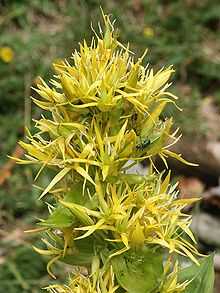Gentiana lutea
| Gentiana lutea | |
|---|---|
 | |
| Scientific classification | |
| Kingdom: | Plantae |
| (unranked): | Angiosperms |
| (unranked): | Eudicots |
| (unranked): | Asterids |
| Order: | Gentianales |
| Family: | Gentianaceae |
| Genus: | Gentiana |
| Species: | G. lutea |
| Binomial name | |
| Gentiana lutea L. | |
Gentiana lutea (great yellow gentian) is a species of gentian native to the mountains of central and southern Europe. Other names include 'yellow gentian', 'bitter root', 'bitterwort', 'centiyane', 'genciana', and "the Devil's taint"[citation needed].
Growth
It is a herbaceous perennial plant, growing to 1–2 m tall, with broad lanceolate to elliptic leaves 10–30 cm long and 4–12 cm broad. The flowers are yellow, with the corolla separated nearly to the base into 5-7 narrow petals. It grows in grassy alpine and sub-alpine pastures, usually on calcareous soils.
Uses

It is remarkable for the intensely bitter properties residing in the root and every part of the herbage, hence they are valuable tonic medicines. The root is the principal vegetable bitter employed in medicine, though the roots of several other species are said to be equally efficacious. Before the introduction of hops, gentian, with many other bitter herbs, was used occasionally in brewing. It is a principal ingredient in Angostura bitters.[1]
The medicinal parts are the dried, underground parts of the plant and the fresh, above-ground parts. The name is a tribute to Gentius, an Illyrian king who was thought[2] to have found out that the herbs had tonic properties. It was used in the Middle Ages as an antidote to certain poisons.
Gentian root has a long history of use as a herbal bitter in the treatment of digestive disorders and is an ingredient of many proprietary medicines. The bitter principles of gentian root are secoiridoid glycosides amarogentin and gentiopicrin. The former is one of the most bitter natural compounds known[3] and is used as a scientific basis for measuring bitterness.
It was considered especially useful in states of exhaustion from chronic disease and in all cases of debility, weakness of the digestive system and lack of appetite. It was also considered one of the best fortifiers of the human system, stimulating the liver, gall bladder and digestive system, and was thought to be an excellent tonic to combine with a purgative in order to prevent its debilitating effects.
In veterinary pharmacopeia in the 1860s gentian root or gentian radix was considered useful as a tonic and stomachic [4]
Chemical constituents
The root is anthelmintic, anti-inflammatory, antiseptic, bitter tonic, cholagogue, emmenagogue, febrifuge, refrigerant and stomachic. It is taken internally in the treatment of liver complaints, indigestion, gastric infections and anorexia. It should not be prescribed for patients with gastric or duodenal ulcers. The root, which can be over 5 cm thick and has few branches, is harvested in the autumn and dried for later use. It is quite likely that the roots of plants that have not flowered are the richest in medicinal properties. Caution should be exercised as to its use because it is endangered, and the closely related Centaurium erythraea shares many of its constituents and actions.
The Gentiana lutea is depicted on the reverse of the Albanian 2000 lekë banknote, issued in 2008, that also depicts king Gentius on its obverse.[5]

Extracts of gentian root can be found in the American soft drink Moxie, and its unique flavor is attributed to that fact. It is also used in France to produce a Limousin speciality liqueur and aperitif, with plants gathered from the Auvergne area.
The European Gentian Association in Lausanne "Cercle Européen d'Etude des Gentianacées" has for objective to develop the knowledge and the uses of the yellow gentian and other species of Gentianaceae.
References
- ↑ http://www.herbsforhealth.com/index.php?page=article&do=view&id=bitters_beverages_moxie
- ↑ A manual of the flowering plants of California by Willis Linn Jepson
- ↑ Heilpflanzen:Gentiana lutea (German)
- ↑ page 126 of Richard V. Tuson; Bayne, James (1895), A pharmacopoeia including the outlines of materia medica and therapeutics for the use of practitioners and students of veterinary medicine (5th ed., rev. & ed. by James Bayne ed.), Philadelphia P. Blakiston, Son & Co, retrieved 28 October 2011 see also http://openlibrary.org/books/OL24167194M/A_pharmacopoeia_including_the_outlines_of_materia_medica_and_therapeutics_for_the_use_of_practitioners_and_students_of_veterinary_medicine
- ↑ Bank of Albania. Currency: Banknotes in circulation. – Retrieved on 23 March 2009.
External links
| Wikimedia Commons has media related to Gentiana lutea. |
- GENTIAN (Gentiana Lutea) - ORAL side effects, medical uses, and drug interactions.
- Heilpflanzen: Gentiana lutea - Gelber Enzian (German)
- Flower Gallery :: Gentianaceae